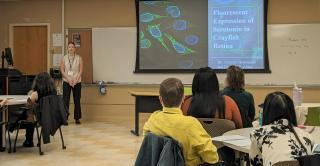
Central Connecticut State University’s clinical education places a traditional and strong emphasis on providing the athletic training student with sufficient opportunities to master the desired competencies and develop clinical proficiency through active participation in providing health care to patients. Formal instruction involves teaching of required subject matter in structured classroom, clinical, or laboratory environments. The clinical component of the Athletic Training Professional Program (ATPP) consists of two distinct components: “clinical education” and “clinical field experience”. The student’s clinical education and clinical field experiences are initially shaped by their academic coursework that evolves in time to practical skill application with actual patients.
Clinical Education
Clinical education are individual courses that are completed over a minimum of two academic years (4 semesters). Clinical education progression is based on course sequencing with the intent to present “learning over time” as the student progresses in acquiring clinical skills.
Students are encouraged to perform any and all skills that are previously learned with direct preceptor supervision. Central’s clinical education also permits students to learn and interact with other medical and health care personnel. All clinical education experiences are educational in nature.
All students involved in the clinical education program have an equal opportunity to be assigned to any of Central’s athletic teams and all off-campus affiliations without consideration of sex, ethnicity, religious affiliation, or sexual orientation. The ATPP abides by Central Connecticut State University (Central) Non Discrimination Policy as stated in the Student Handbook. Athletic training students must be officially enrolled in the program and must be instructed on athletic training skills prior to performing those skills on patients. Observation athletic training students are not to perform any tasks on any patients.
Clinical Field Experience
The clinical field experience plan reinforces the sequence of formal instruction of athletic training knowledge, skills, and clinical abilities, including clinical decision-making. Clinical field experiences permits the student to function in a variety of settings with patients engaged in a range of activities with conditions described in accordance to the role delineation study and standards of practice for the certified entry level athletic trainer. Central's field experience provides students with authentic, real-time opportunities to practice and integrate athletic training knowledge, skills, and clinical abilities, including decision-making and professional behavior in order to develop proficiency as an athletic trainer through assignments with preceptor. Central’s clinical field experiences follows a logical progression that allows for increasing amounts of clinically supervised responsibility leading to autonomous practice upon graduation.
During the clinical field experience aspect of the student’s education, the student will be under the direct supervision of a preceptor athletic trainer and other medical professionals who serve as preceptors. Each clinical experience is designed to provide the student with ample opportunities to progressively develop competencies in the psychomotor and clinical proficiency skills that are necessary for the entry-level athletic trainer. This experience includes practice and game preparation, acute and chronic injury/illness evaluation, first aid and emergency care, follow-up care, rehabilitation, and related services.
The student will have the opportunity to experience athletic practices and competitive events in both men's and women's sports. The athletic training student's clinical field experiences at Central can also be categorized to include general medical issues, upper extremity and lower extremity intensive sports, equipment intensive sports, and high-risk sports. Upper extremity intensive sports include baseball, softball, swimming and volleyball. Lower extremity intensive sports include soccer, cross-country, track, basketball. Equipment intensive sports include football. High-risk sports include football, soccer, basketball, volleyball and lacrosse.



